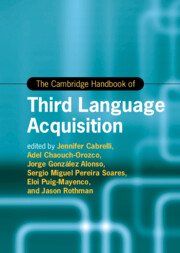Book contents
- The Cambridge Handbook of Third Language Acquisition
- Cambridge Handbooks in Language and Linguistics
- The Cambridge Handbook of Third Language Acquisition
- Copyright page
- Contents
- Figures
- Tables
- Contributors
- Introduction Multilingualism
- Part I Theoretical Approaches to L3/Ln
- Part II L3/Ln across Linguistic Domains
- Part III Becoming and Staying Multilingual at Different Ages
- Part IV L3/Ln in Action
- Part V L3/Ln and Cognition
- Part VI Research Methods in L3/Ln
- 25 Innovations and Challenges in Acquisition and Processing Methodologies for L3/Ln
- 26 Corpus Research
- 27 Case Study Research in Multilingual Contexts
- 28 Using Artificial Languages to Study Third Language Learning and Processing
- 29 Statistical Modeling in L3/Ln Acquisition
- Index
- References
28 - Using Artificial Languages to Study Third Language Learning and Processing
from Part VI - Research Methods in L3/Ln
Published online by Cambridge University Press: 13 July 2023
- The Cambridge Handbook of Third Language Acquisition
- Cambridge Handbooks in Language and Linguistics
- The Cambridge Handbook of Third Language Acquisition
- Copyright page
- Contents
- Figures
- Tables
- Contributors
- Introduction Multilingualism
- Part I Theoretical Approaches to L3/Ln
- Part II L3/Ln across Linguistic Domains
- Part III Becoming and Staying Multilingual at Different Ages
- Part IV L3/Ln in Action
- Part V L3/Ln and Cognition
- Part VI Research Methods in L3/Ln
- 25 Innovations and Challenges in Acquisition and Processing Methodologies for L3/Ln
- 26 Corpus Research
- 27 Case Study Research in Multilingual Contexts
- 28 Using Artificial Languages to Study Third Language Learning and Processing
- 29 Statistical Modeling in L3/Ln Acquisition
- Index
- References
Summary
Artificial linguistic systems are useful for investigating aspects of adult language learning. These systems are typically composed of a lexicon and a set of grammatical rules. Such systems provide advantages for the study of third language acquisition. For example, they enable researchers to control the amount and type of language exposure as well as crosslinguistic similarity to learners’ known languages. This chapter discusses the use of artificial linguistic systems as a methodological tool for investigating topics in adult third language learning, including the effects of first- and second-language transfer on third language learning and potential bilingual advantages in grammar learning. The chapter considers three subtypes of artificial linguistic systems: artificial languages, semi-artificial languages, and mini-languages. In the chapter, I discuss research that has used these artificial systems to examine third language learning/processing, advantages of the systems, and their validity in adult language learning research.
- Type
- Chapter
- Information
- The Cambridge Handbook of Third Language Acquisition , pp. 724 - 743Publisher: Cambridge University PressPrint publication year: 2023
References
- 2
- Cited by

